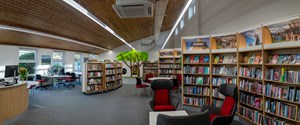Explore a wide range of ideas to broaden the reach and appeal of your library to your reading community. You will experiment with ways to enrich reading lives, connect readers together and target diverse needs and preferences to reach a wide range of people. Starting from the reader will bring a new energy to your strategy and the practical coursework tasks will enable you to experience this powerful dynamic.
The course is structured in three Modules, each with a practical task to complete. Module 1 looks at what motivates readers’ choices and offers practical ways to meet their reading needs, both in the library and online. Module 2 examines how to create a feeling of change in the library experience, both physically and digitally. Module 3 takes you through methods of differentiating the reading audiences within your community and gives examples of tried and tested ways of reaching them, going beyond the traditional and expected promotional routes. You’ll plan your own unique reading promotion or reader-centred event.
Your Mentor will give detailed feedback and support on your three tasks. Their role is to use their experience to stretch your thinking and to help you adapt the course content to your own workplace and your role. You will work across the whole collection of fiction and non-fiction.The coursework is supported by a set of short training sessions you can use with frontline staff as well as downloadable print and digital resources.
My mentor helped me analyse every single part from the research to the feedback phase. That was great!
Wendy Bronquer Monash Public Library Service Australia
This comprehensive course challenged me to step outside of my comfort zone and supported me to do so. I received good encouragement and appreciated the insightful feedback from my mentor. The elements of trying to target a particular group and focus on their needs has been very enlightening. I can see that unexpected information can come from this process – and that just assuming what groups of people may want or need is not always going to result in a suitable event or project. It’s all a learning experience and you can gain knowledge by just giving things a go.
Robyn Smith Victoria State Library Australia
The biggest takeaway for me was it expanded my mind when thinking of a target group. It made me more open to making reader connections based on the real positive impacts it could have to these readers, rather than just approaching it from a library point of view of getting people through our doors. I thought the course was well set out and I enjoyed doing it. Thanks!
Sepe Illig Victoria State Library Australia

| The reader-centred library | |
| The reader-centred approach | |
| What readers want | |
| Enriching more reading lives | |
| The reading experience | |
| Quality reading experiences | |
| Spot checks on range | |
| Your reading community | |
| Making readers visible | |
| Connecting readers | |
| Increasing people’s confidence | |
| Researching reading needs | |
| Connecting offline readers with those online | |
| Task One: Try out an idea to link online and offline readers | |
| Extra: Ideas for staff training sessions |

| The library USP | |
| Libraries are not static | |
| Understanding physical factors | |
| Understanding psychological factors | |
| Book marketing for libraries | |
| Using single not multiple copies | |
| Book cover fashions | |
| Keep the message consistent | |
| Engaging displays | |
| Everyday merchandising | |
| Making non-fiction more engaging for readers | |
| Merchandising works in non-fiction too | |
| Extending your reach | |
| Creating a feeling of change in your library | |
| Creating a feeling of change online | |
| Measuring success | |
| Task Two: Curate a Trending display | |
| Building your grid of book covers | |
| Discussion with your Mentor | |
| Extra: Ideas for training sessions |

| The importance of targeting | |
| Targeting is not stereotyping | |
| Visible and invisible borrowers | |
| Differentiate, don’t alienate | |
| Quick wins and long-term projects | |
| Targeting traditional audiences | |
| Targeting the way people engage with the library | |
| Targeting loyal supporters | |
| ‘Hard to reach’ audiences | |
| Reader-centred events | |
| Task Three: Ideas for a promotion to target a reading audience | |
| Task Three: Design a promotion to target a reading audience | |
| Learning review | |
| More Opening the Book courses | |
| Credits |
 Prices displayed in CAD
Prices displayed in CAD
